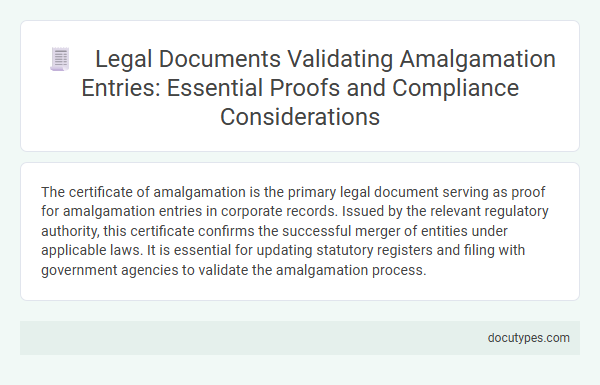The certificate of amalgamation is the primary legal document serving as proof for amalgamation entries in corporate records. Issued by the relevant regulatory authority, this certificate confirms the successful merger of entities under applicable laws. It is essential for updating statutory registers and filing with government agencies to validate the amalgamation process.
Introduction to Amalgamation and Legal Documentation
| Topic | Details |
|---|---|
| Introduction to Amalgamation | Amalgamation refers to the merging of two or more companies into a single entity. It is a corporate restructuring process aimed at consolidating resources, enhancing efficiency, and expanding market reach. |
| Significance of Legal Documentation | Legal documentation provides formal evidence and authorization for the amalgamation process. These documents ensure compliance with regulatory requirements and protect the interests of all stakeholders involved. |
| Primary Legal Document as Proof | The Certified Copy of the Scheme of Amalgamation sanctioned by the National Company Law Tribunal (NCLT) acts as definitive proof for amalgamation entries in accounting and legal records. This sanctioned scheme outlines terms, conditions, and approval of the amalgamation. |
| Additional Supporting Documents | Articles of Association (AOA) amendments, Shareholder resolutions, and Court orders supplement the primary legal proof by detailing procedural compliance and approvals. |
| Regulatory Framework | Amalgamation processes are governed by company laws and regulations such as the Companies Act, 2013 in India, ensuring legality and transparency in documentation and entries. |
Key Legal Documents Validating Amalgamation
Proof for amalgamation entries is primarily established through specific legal documents that validate the transaction. These documents ensure compliance with regulatory requirements and provide evidence of the merger's authenticity.
- Scheme of Amalgamation - A court-approved plan detailing the terms and conditions of the merger between the companies involved.
- Board Resolutions - Formal approvals by the boards of the merging entities authorizing the amalgamation process.
- Certificate of Incorporation - Issued by the registrar confirming the creation of the new entity post-amalgamation.
Statutory Requirements for Amalgamation Entries
The primary legal document serving as proof for amalgamation entries is the Certificate of Amalgamation issued by the relevant Registrar of Companies. This certificate confirms compliance with statutory requirements under corporate laws, validating the merger or consolidation of entities. You must ensure the certificate is duly filed and retained to support all official amalgamation records.
Role of Merger and Amalgamation Agreements
The primary legal document serving as proof for amalgamation entries is the Merger and Amalgamation Agreement. This agreement outlines the terms, conditions, and obligations of the merging entities, ensuring compliance with regulatory requirements.
Merger and Amalgamation Agreements play a critical role in documenting the intent and approval of all involved parties. They contain detailed provisions on asset transfers, share exchanges, and liabilities, which form the basis for accounting and legal records. These documents are essential for auditors, legal authorities, and regulatory bodies to verify the legitimacy of amalgamation entries in financial statements.
Court and Tribunal Orders: Validity and Enforceability
Court and tribunal orders serve as crucial legal documents providing proof for amalgamation entries. These orders confirm the validity and enforceability of the amalgamation process under applicable laws.
- Legal Authority - Court and tribunal orders are issued by competent authorities with jurisdiction over corporate mergers and amalgamations.
- Binding Effect - These orders carry binding legal force, ensuring that the amalgamation is recognized by all parties and regulatory bodies.
- Evidence of Compliance - The orders demonstrate compliance with statutory requirements, providing solid evidence for accounting and legal records.
Your reliance on court and tribunal orders ensures that amalgamation entries are legally validated and enforceable in all relevant jurisdictions.
Shareholder and Board Resolutions as Proofs
Shareholder and board resolutions serve as key legal documents proving amalgamation entries in corporate transactions. These resolutions formally approve the merger terms and authorize the necessary actions for amalgamation. Courts and regulatory authorities rely on these documented approvals to validate the legality and accuracy of the amalgamation process.
Regulatory Filings and Approvals for Amalgamation
What legal document serves as proof for amalgamation entries in regulatory filings and approvals? The Scheme of Amalgamation approved by the National Company Law Tribunal (NCLT) acts as the primary legal document. This approval, along with the certified copy of the order, provides conclusive evidence for amalgamation in accounting and legal records.
Registrar of Companies Compliance Checklist
The legal document that serves as proof for amalgamation entries is the Certificate of Amalgamation issued by the Registrar of Companies (ROC). This certificate confirms that the amalgamation complies with statutory requirements and is officially recorded.
The Registrar of Companies Compliance Checklist ensures all necessary documents and filings are submitted accurately for the approval of the amalgamation. You must verify the completion of each requirement before proceeding with your submission to maintain regulatory compliance.
- Certificate of Amalgamation - Official document issued by the ROC proving the amalgamation is legally recognized.
- Amalgamation Agreement - Detailed contract outlining the terms and conditions agreed upon by the merging companies, essential for ROC approval.
- Filing of Form INC-28 - Mandatory application for issuance of the Certificate of Amalgamation, submitted post-ROC approval to finalize entry in official records.
Maintaining Audit Trails and Records for Amalgamation
The legal document that serves as proof for amalgamation entries is the Scheme of Amalgamation approved by the National Company Law Tribunal (NCLT). This document provides the official authorization and detailed terms of the amalgamation, ensuring compliance with regulatory requirements.
Maintaining audit trails and records for amalgamation involves preserving copies of the Scheme of Amalgamation, NCLT approval orders, and related financial documents. These records support transparency and accountability during audits and facilitate verification of the amalgamation process.
What Legal Document Serves as Proof for Amalgamation Entries? Infographic

